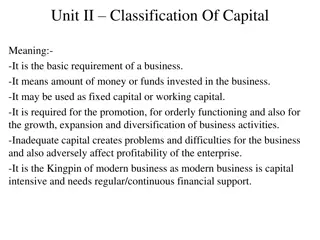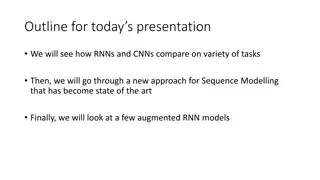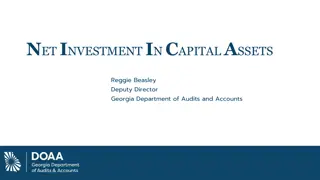
Risk-Based Capital Modelling in Insurance Industry
Explore the significance of risk-based capital modelling in the insurance sector, comparing it to traditional approaches. Learn about the key components, advantages, and disadvantages of risk-based capital, along with the importance of regulatory compliance and future solvency assessments.
Uploaded on | 2 Views
Download Presentation

Please find below an Image/Link to download the presentation.
The content on the website is provided AS IS for your information and personal use only. It may not be sold, licensed, or shared on other websites without obtaining consent from the author. If you encounter any issues during the download, it is possible that the publisher has removed the file from their server.
You are allowed to download the files provided on this website for personal or commercial use, subject to the condition that they are used lawfully. All files are the property of their respective owners.
The content on the website is provided AS IS for your information and personal use only. It may not be sold, licensed, or shared on other websites without obtaining consent from the author.
E N D
Presentation Transcript
Capital Modelling Nne Nwankwo, FIA, CERA 27thJanuary 2022
2 Introduction This presentation discusses capital modelling: Current approach Risk-based approach Consideration will also be given to: Principles behind capital modelling and why it is important Key components of the risk-based capital approach Main risks to consider under the risk-based capital approach Advantages of risk-based capital Disadvantages of risk-based capital Additional considerations
3 Capital Modelling what is it? Determines how much capital an insurer needs to hold to mitigate against all manner of risks including liabilities, particularly in scenarios where the company may be under stress Example: An insurer may need to hold $10bn of capital in order to meet solvency requirements of 130% Assess future solvency and capital needs Solvency: Assets > Liabilities Involves projection of assets and liabilities Tool for understanding risk profile Assists with making sound business decisions Regulatory capital requirements
4 Capital Modelling current landscape Fixed capital standards used for modelling the financial solvency of insurance companies All insurance companies need to hold the same minimum amount of capital Minimum Capital Required (2007) (NGN Bn) Minimum Capital Required (2019) (NGN Bn) Entity Life Insurance 2 8 General Insurance 3 10 Composite 5 18 Reinsurance 10 20 + Simple, not-onerous for the regulator, easy to audit, BUT - Does not consider financial condition, size and risk profile - Does not address the variation in risks across sectors and companies - Does not address the size of insurers in determining the appropriate minimum amount of capital
5 Risk-Based Capital RBC is garnering global recognition as the dominant approach for regulatory insurance supervision Fits in with wider risk-based supervision framework which links risk management with management of capital adequacy Risk-based capital reflects the risk profile of an insurance company and allows it to take on risks depending on its financial strength Insurance companies with higher risk are expected to hold larger amounts of capital Main components: Adding up the main risks commonly faced Allowing for diversification benefits by considering potential dependencies across the risks
6 Risk-Based Capital -Background Risk-based capital has been employed across a number of countries Sets out insurance regulations with the key objectives of: Improved customer protection/increase confidence in insurance industry Aligning capital requirements with underlying risk Strengthened market integration More competitive market 3 pillar approach: Pillar I: Financial requirements Pillar II: Governance and supervision Pillar III: Reporting & Disclosure
Risk-Based Capital Around the World 7 SII equivalence SII SII SST RBC C-ROSS BSCR RBC2 SII equivalence SAM SII equivalence
8 Risk-Based Capital -Requirements Insurance companies should be solvent above a minimum level: Assets exceed liabilities The Solvency Capital Requirement (SCR) should deliver a level of capital that enables an insurance undertaking to absorb significant unforeseen losses and gives reasonable assurance to policyholders that payments will be made as they fall due. IFoA The Minimum Capital Requirement (MCR) is the minimum regulatory capital requirement; the breach of which would trigger major regulatory intervention - IFoA Main rule: Solvency ratio = Own funds > 100% SCR
9 Risk-Based Capital Capital Composition The risk-based capital requirement Solvency Capital Requirement (SCR) covers: Underwriting risk Market risk Credit risk Operational risk The SCR can be calculated using: A prescribed formulaic approach A bespoke internal model A mixture of both (partial internal model) The calculation will be calibrated with the aim of ensuring X% confidence over a 1 year period
10 Risk-Based Balance Sheet Taken from Society of Actuaries, Ireland
11 Risk-Based Capital -Breakdown The calculation will be calibrated with the aim of ensuring a % level of confidence over a 1 year period Taken from Institute and Faculty of Actuaries, UK
12 Non-Life Risk Non-life risk: risk of losses stemming from the uncertainty in results of the insurer s underwriting Premium risk: Prospective approach will premiums cover expected losses over a given time horizon? Reserve risk: Retrospective approach have sufficient reserves been set aside to cover future deterioration on existing claims? Considerations: Size of claims provisions (N5m vs N25m vs N150m) Class of business (Personal accident vs Property vs Liability) Geographical location (Nigeria vs UK vs US) Loss ratios (90% vs 120%) Currency (N, $, , , )
13 Life Risk Life risk: risk of losses or adverse change in value of life insurance obligations stemming from changes in the level, trend or volatility in mortality and morbidity rates. Considerations: Mortality Longevity Morbidity Improvements in technology Legal environment
14 Health Risk Health risk: risk of losses or adverse change in value of life insurance obligations stemming from changes in the level, trend or volatility in health insurance obligations. Considerations: Outbreaks of major epidemics Accumulation of risks under extreme circumstances Expenses Improvements in technology Legal environment
15 Market Risk Market risk: Risk of losses stemming from the volatility in market prices of financial instruments Considerations: Nature of investments (fixed income vs property vs equity) Currency (also impacts liabilities) Interest rates (also impacts liabilities) Spread Concentration
16 Credit Risk Credit risk: Risk of losses or adverse change in the financial situation of an insurer as a result of fluctuations in the credit standing of counterparties and any debtors to which the insurer is exposed. Considerations: Credit rating of counterparty (AAA vs A vs BBB) Probability of counterparty defaulting on obligations Reinsurance assets expected from counterparty Expected loss in the event of default Other receivables expected from intermediaries
17 Operational Risk Operational risk: The risk of losses as a result of inadequate or failed internal processes, people and systems or due to external events. Inadequate internal resources IT risks Business interruption Legal risks Other risks that are not explicitly included in other risk modules Considerations: Fixed uplift of X% Formulaic approach Risk register Inherent risks, mitigation, residual risks
18 Diversification The adverse outcome from one risk/risk group can be offset by more favourable outcomes from another risk, where those risks are not fully correlated Market Default Market 1 Default 0.25 1 Life 0.25 0.25 Health 0.25 0.25 Non-Life 0.25 0.5 Life Health Non-Life 1 0.25 0 1 0 1 Reduction in risk exposure of insurer = capital saving Considerations: Diversification within risk categories (e.g. classes of business, geographical location) Diversification between risk categories (e.g. insurance risk and market risk) Correlation matrix per SII Standard Forumla
19 Risk Metrics Value at Risk (VaR) The amount of capital required to ensure (at given confidence level), that the risk bearing entity does not become insolvent Answers the question: what level of capital is needed to cover losses x% of the time? reflects a chosen distribution of aggregate losses . the 99.5thprobability level indicates the level of adverse outcome such that the probability of exceeding this threshold is 5% percentile of the Value at Risk (TVaR) Quantifies the expected loss on the condition that loss exceeds the Xth percentile Takes into account all scenarios worse than VaR and therefore is more prudent for the same calibration Diagram curtesy of Swiss Re
20 Advantages of Risk-Based Approach Increased policyholder protection Increased confidence in insurance industry Capital reflects risk profile of insurance undertaking More efficient use of capital within insurance undertakings Holistic approach to risk Deeper understanding of undertaking Aids with making sound financial decisions Competition Alignment with internationally adopted approaches
21 Disadvantages of Risk-Based Approach Complexity Understanding regulatory guidance Prescribed formula vs internal capital model Onerous data requirements Costs of implementation Associated corporate governance
22 Additional Considerations The industry s preparedness Getting senior management on board Implications throughout the insurance undertaking Insurer s risk appetite Actuarial expertise Adequacy of internal resources Understanding and interpreting the risk metric Risk-based capital becoming business as usual
23 THANKS! Nne Nwankwo, FIA, CERA contact@actuaries.org.ng






















